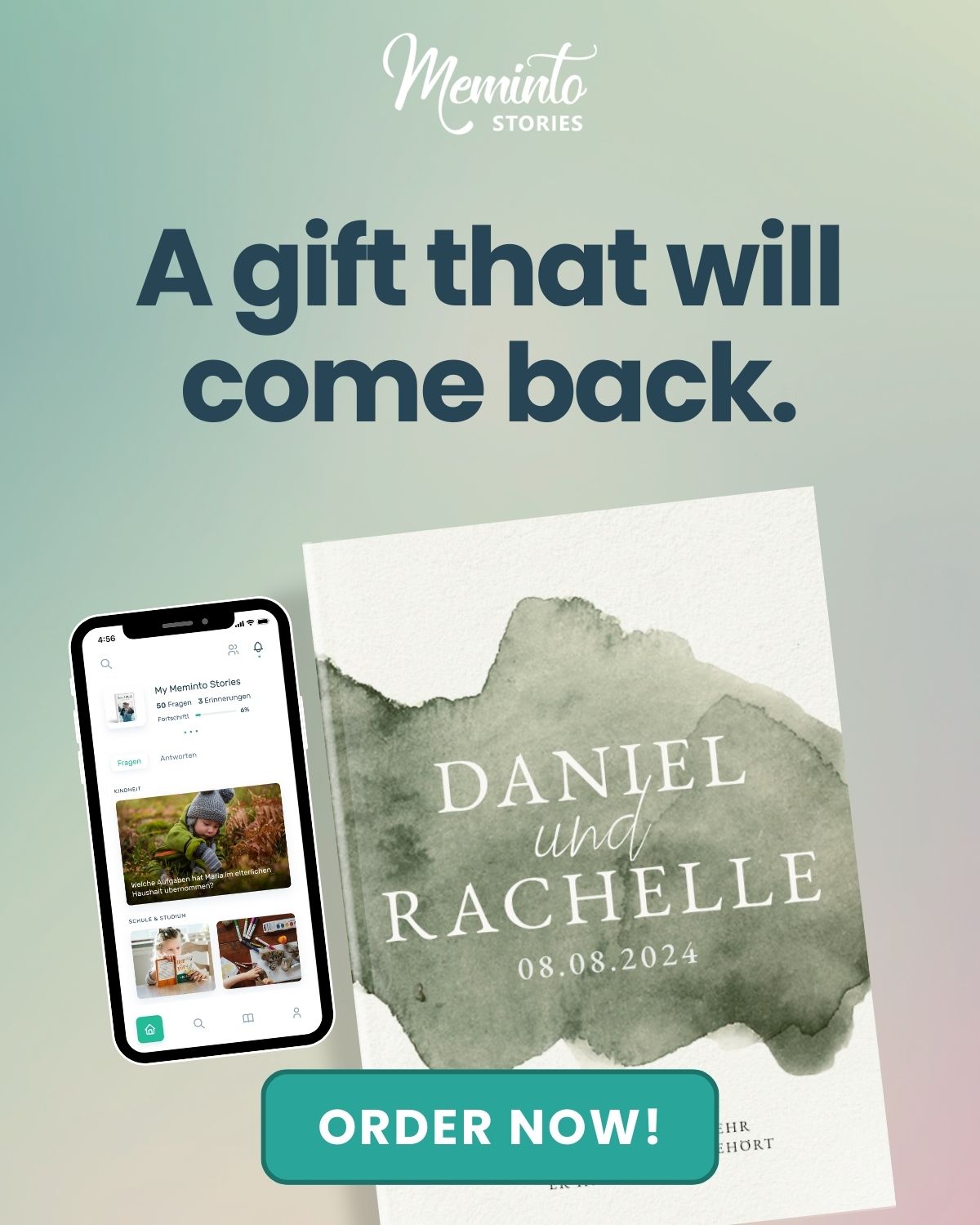To write a story about your life, start by journaling or free-writing to capture memories. Create a narrative structure, explore themes, and be honest about your experiences for authenticity and connection with readers.
Everyone has a story, although some life journeys are truly extraordinary and really do need to be shared. Writing your personal life story is a different kind of journey altogether from writing fiction or the biography of someone else. At the same time, your story is so important. It’s your life; it’s your legacy.
This story can be treasured by your children and then passed down generation by generation, preserving your legacy for generations to come. If this speaks to you, we’d love to help you on that journey.
Take out a pen and paper, or open up your laptop, and begin journaling or free-writing about those at the top of your list. You can even compose an outline of some sort.
Most importantly, make a commitment to yourself that you are going to see your story through until it’s done! But compared with the development of characters in novels, this is about your personal journey with your readers. That’s writing on a very personal level—and very rewarding.
If you have an amazing story to share but don’t know how to begin, then let us help you decide in what form you should write about your life.
Key Takeaways
- Writing a story about your life is a profound journey of self-discovery and expression. Whether you’re considering an autobiography or a memoir, capturing your unique experiences requires careful planning and reflection.
- Focus on key themes and truths to make your memoir or autobiography engaging and meaningful, such as facing adversity, personal growth, or family dynamics.

How to Write a Story About Your Life
1. Pre-Write
Pre-writing is the first step in writing a story about your life. This step occurs before writing your autobiography, whereby you jot down notes or brainstorm ideas for what to write. Pre-writing helps kickstart your writing process by capturing the richness of your experience and organizing ideas.
Begin with free writing about your life. This style of writing does not concern itself with structure or prompts. Don’t try to edit as you go.
If you write freely, you will learn more than you may have ever thought was there. Your mind wanders through different paths, and surprisingly, you find connections between people and events.
Pre-writing is a kind of personal learning experience that helps one’s brain organize life stories. It can help you see themes and emotional patterns that repeat throughout your life. For example, you could discover a pattern of overcoming hardships or a theme repeated over time of love and loss.
Tools like mind maps or lists can be helpful in the organization of your pre-writing notes. Mind maps are a means of visual connection between events and themes, with the objective of further developing relations between various parts of your story.
In turn, lists can be organized chronologically or thematically, which will help you build up a clear structure for your narrative.
Reflecting on the insights and lessons learned at this phase can be very exciting. While working on one childhood story, I remember that one repetitive factor stuck out: my mother’s unwavering support made me realize how much I had struggled through. Not only did this enrich my story, but it also provided insight into my character.
Avoid judging your pre-writing. Instead, embrace this phase as an opportunity for self-discovery and reflection, allowing your story to unfold naturally and authentically.
2. Follow a Narrative Structure
Real life doesn’t follow a neat story arc, but it is important to use at least the basic story structure when writing a memoir or autobiography.
A basic plot structure would include an introduction, rising action, climax, falling action, and resolution. These ensure the construction of a captivating storyline.
For instance, when writing your life story, the introduction sets the stage and introduces characters; the rising action develops tension; the climax is the turning point; the falling action depicts the after-effects of the situation; and the resolution ties up loose ends.
Though life is more complex than just a simple story, it does contain these elements. Identify natural transitions in your life, such as beginnings, highs and lows, and endings.
These transitions could be the start of a new job, overcoming a big challenge, or the end of a relationship. Use those moments to create a narrative structure for your story.
Characters are more readily recognizable. You’re the main character in your life’s story. Even if you don’t have an identified antagonist, you’ll have sidekicks—people who are important, have been in your life or have made any appreciable difference in your story. Describe them as multi-dimensional, fleshed-out characters, not just wallpapers.
In every story or event you write, highlight the conflict and how you resolved it. Apply this approach to serious or light events, and then every important moment should amount to a scene with a problem and conflict.
3. Pick Your Genre
Nonfiction encompasses a variety of genres that stretch into memoirs, essay collections, autobiographies, and motivational books. If you’re writing about your life, you might think you have to choose the “memoir” genre—in reality, you’re far from it.
Not quite sure whether your story is a memoir or an autobiography? Here’s a guide:
There is a critical difference between memoir and autobiography, which revolves around their main focal points. Memoirs focus on only one period or “memory” in your life; autobiographies refer to a big canvas of your entire life. For example, fighting an illness, relocating to a new country, or acquiring an extraordinary pet.
Autobiographies, on the other hand, cover your entire life, from birth to the present, detailing your achievements and significant moments.
While more fact-based, autobiographies are written using creative techniques ranging from vivid description to narrative storytelling.
But what if neither fits your story?
Perhaps a personal/lyrical essay collection is more to your liking if you’re not inclined to work within the boundaries of a specific period or wish to tell your entire life story. Such a format would then play off your style and give you multiple viewpoints in life to share.
Here’s a decision-making framework to help you choose the right genre for your life story:
1. Scope of Your Story
- Memoir: Focus on some period or a big event in your life.
- Autobiography: Your whole life, from birth to the present.
- Essay Collection: Share different aspects or themes of your life in separate essays.
2. Purpose
- Memoir: Reflect upon and share the things gained from part of the experience.
- Autobiography: Provide a detailed account of one’s entire life journey.
- Essay Collection: Explore different themes, experiences, or viewpoints without a chronological constraint.
3. Writing Style
- Memoir: The tone has to be personable and reflective, focusing on feelings and lessons learned.
- Autobiography: This would include firm accounts and factual events, along with possible creative narrative elements.
- Essay Collection: Use a flexible style, ranging from reflective to analytical, depending on the essay’s focus.
4. Audience
- Memoir: Engage readers interested in a particular experience or theme.
- Autobiography: Engage readers who would like to read and understand your life story and all your accomplishments.
- Essay Collection: Appeal to readers who enjoy varied topics with a tang of personal insight.
4. Research
Whether you start with free writing or outlining, research can be useful in expanding on the basic memories, making the story more detailed, and establishing credibility.
Memories may be unreliable and stretched for events that happened long ago. Doing research for your story may sound like a daunting task, but it is what a writer needs to do so as to come up with an elaborate and precise narrative. Though only a little research may actually make it into your story, knowing what’s valuable necessitates careful research using particular methods like looking over old photos and diaries, conducting interviews, checking newspapers, or other primary sources.
The need for research applies to each type of writing, not excluding autobiographies. The fact that you lived through these experiences does not exempt you from doing this.
Yes, you can write from memory, but facts may remain somewhat hazy. Approach your life like a journalist—you know, lookout for old photos and diaries. Talk to people who were there to get their memories of the events you write about.
You could be looking for newspapers or other primary sources that will provide background information and details of the setting. For instance, if you participated in any college sporting event whose details you cannot remember, you can always go through school newspapers.
It will also dig out forgotten memories that may fit well into your story and give you new perspectives on past events. Details are very important in a true story; therefore, research must be done accurately to have as many facts as possible.
While including information from your research, it is necessary to reference where you have derived the information from. It doesn’t only give credit to the sources but also helps enhance your credibility as a writer. You prove you did your homework, and there is a way for readers to check the information presented.
5. Identify characters and perspectives
The people you have met in your lifetime have made you the person you are now and will automatically be a part of your story.
To structure these characters appropriately, first create a list of everyone you would like to include. Consider these people as “characters” in your story.
Describe each person in detail, including their appearance, age, and background. Further, document the relationship to you and whether you are close or distant.
You can use a character bio template from SelfPublishing.com to really go deep into the description of a character. You describe only your characters, following the “show, don’t tell” rule, and then the reader pictures this person in his mind to see how he impacts your life.
You may want to replace real names to protect your subjects. If you don’t have permission to use the person’s real name, change the name and add a note at the top of your story. Also, be sure to make a record of those changes in your character list so you will know who is really who.
Although this is a story about your life, told from your perspective, it’s still relevant to give other characters’ points of view. This gives depth to the narrative and prevents it from becoming one-sided.
6. Add speculation
When it comes to time to write your life story, “speculation” can get you over gaps. If you’re less-than-certain about the motivations of character A, or perhaps your memory is a little fuzzy around the edges, you use what you know and the research you did to fill in those gaps with educated guesses.
Here’s an example of how to write speculation:
“I don’t know why my grandparents suddenly decided to sell the family farm. They were always so proud of it, and it seemed like an odd choice.
Maybe they were struggling more than they let on. I wonder if the long hours and hard work finally took a toll on their health. Perhaps they wanted a simpler life in their later years, free from the responsibilities of the farm.”
The use of such phrases as “maybe,” “perhaps,” and “I wonder if” signals to readers that what you are going to say is your guess.
It’s okay to get creative with the speculation, however. You’re still telling a true story; you’re just forming a hypothesis based on your knowledge to fill in the blanks.
If you were to present these speculations as facts without evidence, it could lead to issues.
7. Determine the setting
Readers need to know where your life events took place, just like in a novel. Setting serves to define you and is not simply a matter of including geographical information.
To identify the setting of your story, answer these questions:
- Where did this event happen?
- What did the place look like?
- Did you enjoy being there?
- Are there any memorable smells from that place?
- What was the culture like?
- Were you a part of the culture or just observing it?
- How did the setting influence your experience?
- What mood did the setting create?
Details like these have made a huge difference in your life, much more than you can imagine, and they should be part of your story. It’s not just a way by which the readers see what it is that you are talking about; it has to do with forming an effective reading experience as well.
8. Remember the dialogue
Dialogue is important, even in a nonfiction story. If there wasn’t any dialogue, it might read like a textbook. It makes your writing and your story come alive.
But there are limitations to the way most people recall dialogue. Unless you videotaped or taped conversations, which you almost certainly didn’t, you’re going to forget some of the words.
Write down what you do remember and do so as precisely as you can, but paraphrasing is okay too. Still in touch with that person to whom you spoke? You can ask them about the conversation. And for quoted dialogue, if at all possible, make sure to give them a chance to check your quotes for accuracy.
In writing dialogue, use correct formatting and tags to show who is speaking, just like you would in fiction. Offset the direct quotes by using quotation marks or italics to set them apart from other text. This will not only clearly present the words as spoken but also create the flow of your narrative.
Properly attributing the dialogue adds credibility and authenticity. If you paraphrase, make that clear to the reader. You could have a lead-in phrase such as “She said something like” or “He recalled.” Then readers know that even if the exact words are not accurate, the meaning of the dialogue is true.
9. Show Your Shortcomings
In writing a story of your life, you need to be transparent and forthright. Obviously, one would want people to view him the best way possible, but the act of trying to appear perfect is far from reality.
People are messy. We stumble, make mistakes and say things we wish we hadn’t said. Sometimes we are the villains of our own stories. For example, in her memoir “Wild,” Cheryl Strayed apparently describes her struggles with grief, drugs, and adultery. It is precisely these complexities that make her story so relatable and authentic.
Memoirs and autobiographies are read to connect with real human experiences. They love a raw account of your life. People look up to you because you can be honest about your flaws.
Your story is remarkable on the very concept that your life has no setbacks or mistakes but how you rise above them and learn from your mistakes. Readers want to see your struggles so they can cheer for your triumphs. Your disappointments and missteps may inspire others and stay with them in spirit.
10. Get Permission
The proper handling of legal matters within a true story in writing will avoid problems after the story has been published.
First, obtain permission to use the real names of people in your life. If they do not want to be featured, try to respect their will, even if it will involve changing part of your story.
You can change the name of places or businesses if you describe them negatively; this will help you avoid a defamation suit.
Avoid using your story as a weapon against or insult to someone else. Every story has another side, most of which you may not agree with. There are libel and slander laws on the books, and breaking them is expensive.
When in doubt about privacy and defamation laws, consult a legal expert. They can provide guidance on how to navigate these issues and ensure that your story is legally sound. Taking this step can save you from potential legal troubles and help you handle sensitive matters responsibly.
11. End on a High Note
Not all stories have a happy ending, so do not go out of your way to devise a fairy tale ending. Readers come to memoirs and autobiographies for inspiration, not only in their own lives but also in the stories of those who have managed to beat the odds that life has thrown at them.
One should end high-note with reflection and a meaningful message to the readers. In autobiographical writing, you end by giving the lessons learned through one’s experiences. Reflect on how your story has shaped you or revealed universal truths. Through your journey, this is your opportunity to impart wisdom.
For instance, Tara Westover concludes her memoir “Educated” by reflecting on the power of education and how it transformed her life despite growing up in a really hard upbringing. Similarly, but finally, Michelle Obama’s book “Becoming” closes with reflections about personal growth and the importance of finding your own voice.
Think of why you sat down to write your life story in the first place. Connect that to your ending. Think of what you would want your readers to learn or feel as they finish reading your memoir.
Sample of Personal Life Story PDF Online
We created sample life stories here to inspire you to create yours.
Download Sample Life Stories PDF
How to Create a Life Book With a Compelling Life Story
Using sample life story templates, you can create your own life book with a compelling story. Here’s a step-by-step guide on how to use Meminto to create a life book:
- Visit https://meminto.com/product/life-book/ and click on “Get Started.”
- Choose who the book is for by selecting either “I will” or “Someone else will.”
- Decide the number of pages for your book and choose if you want additional or digital copies. Then, click “Add to Cart.”
- Enter your shipping address and payment details, and apply a promo code if you have one.
- Review your order on the check-out page and confirm it.
- Look for a confirmation email with an activation code. Copy the code and go to https://memin.to/register.
- Complete the registration form with your details, activation code, and password. Click “Sign up for Meminto” to begin creating your story.
- Choose your preferred language (German or English), select the day to receive weekly questions, and click “Save Changes.”
- Select your book’s typographic alignment and category presentation.
- Customize the book according to your preferences.
- Watch the video below for more details on using the Meminto app.
You are currently viewing a placeholder content from YouTube. To access the actual content, click the button below. Please note that doing so will share data with third-party providers.
More InformationConclusion
Writing a story about your life is an intense journey. It involves looking inward and revisiting memories that may be difficult. However, it’s also a transformative process. You’ll discover that you have valuable wisdom and perspectives to offer the world.
When you start writing, think about the key themes, messages, and universal truths of your life. These elements make memoirs and autobiographies meaningful and engaging for readers. Above all, remember that your story is important and worth sharing.
To streamline the process of writing a story about yourself, you can use Meminto to start writing your life story. With Meminto, all you need to do is answer the available preloaded questions.
You also get an opportunity to add your own questions. You can answer the questions using videos, audio recordings, text, or images. Your responses are easily shareable, downloadable, or printable to preserve as cherished memories.

















